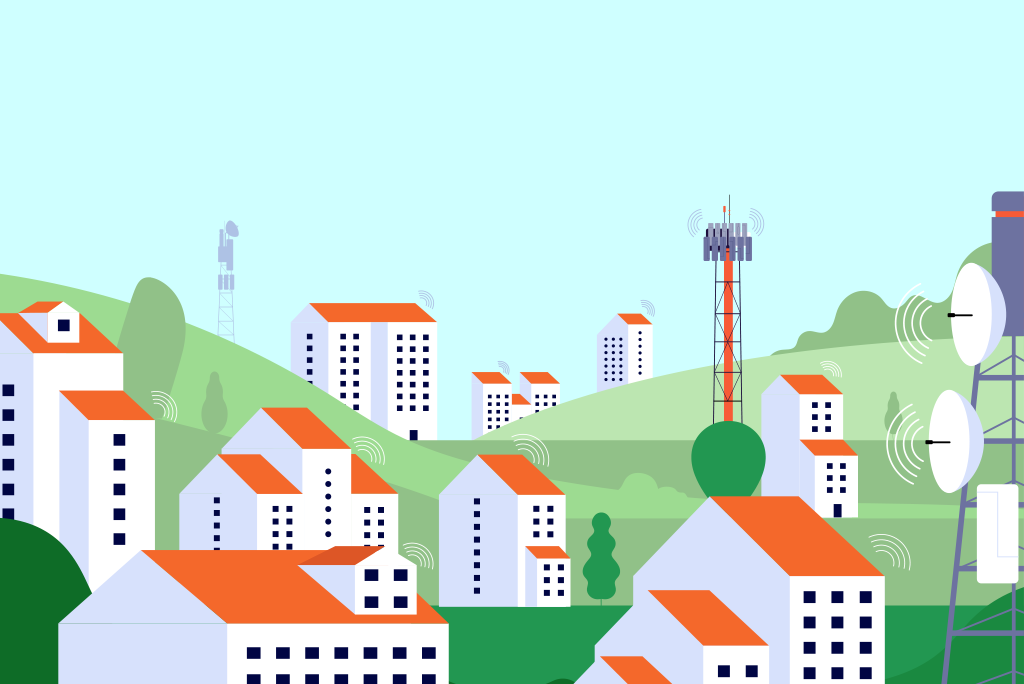
Next-generation 5G wireless technology has the power to transform local communities into smart cities. With help from sensors connected to 5G networks, local officials would be able to collect data that would tell them how to improve air quality and prevent wildfires, traffic lights would be able to “talk” to each other in order to reduce traffic, and farmers would have insight into how to increase crop yields.
Unfortunately, 5G networks pose challenges for local communities. In order to deliver the lightning-fast internet speeds promised of 5G networks, “cell sites” need to be erected closely together (about 500 feet apart over long distances). This means the roughly three-foot tall antennas will need to be fixed to buildings, telephone poles, and other infrastructure.
Ruling Limits U.S. Municipality Regulations of 5G
In the United States, the Federal Communications Commission (FCC), which oversees 5G development as well as broadband, cable, and satellite in the private and public domains, wants to ensure a speedy rollout of 5G technology across the country. However, many local governments are seeking to regulate 5G. These local municipalities want the benefits of 5G technology, but some have concerns over how it will impact their communities.
A major concern is the appearance of cell sites, which many residents consider unattractive. While cell sites can be fixed to existing infrastructure, new cell site poles will need to be constructed in areas with no existing infrastructure, such as beaches and parks. Another substantial concern for municipalities is the cost and time it can take to review and process cell site applications. With these concerns, dozens of U.S. municipalities have sought to impose regulations that would require telecoms to pay user fees and follow guidelines on cell sites appearances. However, the FCC fears such regulations will impede the rollout of 5G.
In September, the 9th U.S. Circuit Court of Appeals mostly upheld FCC rules from 2018 that would limit the ability of local governments to regulate 5G cell site installations. The ruling sided with the FCC by imposing caps on how much municipalities can charge telecom companies for cell sites, and by limiting the length of time municipalities can spend on reviewing applications for permits and zoning.
The ruling will allow municipalities to impose some regulations though. Cities can perform cost assessments for the amount of time it takes to review cell site applications, which could potentially allow them to charge higher application fees. However, it would limit their ability to charge higher annual fees, since less work will be required after a cell site has already been installed. The ruling also gives cities the ability to impose aesthetic guidelines on the appearance of cell sites. For instance, municipalities could possibly require telecoms to build 5G cell sites underground.
“The 9th Circuit decision suggests cities do have the authority to access fees over and above safe harbor, they just need to justify it as related to costs,” Angelina Panettieri, the principal associate for technology and communications for the National League of Cities, told Nextgov.
While it wasn’t entirely a win-win, the ruling provides municipalities with enough leeway to begin preparations for negotiating 5G rollouts.
Understanding 5G Networks
As technology evolves toward 5G, it’s vital for technical professionals and industry leaders to understand how to deliver on the 5G vision while meeting consumer demand for higher communication speeds. Is your organization ready? Consider training your team with 5G Networks, a three-course program from IEEE and Nokia.
Connect with an IEEE Content Specialist today to learn more about the program.
Interested in learning more about 5G for yourself? Visit the IEEE Learning Network today!
Resources
Fernandez, Jean-Gabriel. (1 October 2020). Milwaukee’s Local Government Struggles for Control in Federal 5G Rollout. Shepherd Express.
Noble, Andrea. (22 September 2020). After Decision Upholding FCC’s 5G Rules, Cities Now Weighing Appeal. Nextgov.
Fernandez, Marisa. FCC: 5G could eventually help cities predict and prevent wildfires. Axios.


[…] Meanwhile, major telecommunications companies are struggling to expand 5G networks due to lengthy cell site installations and delays in many regions caused by the COVID-19 pandemic. As a result, it could take years for 5G […]
[…] rollouts will continue to take time, especially in the rural U.S. However, with carriers fiercely vying to expand prized mid-band networks, the transition to 5G is […]
[…] In the past, real estate valuation studies largely focused on the impact of larger wireless towers (“marco sites”), rather than smaller 5G cells sites. Typically, these smaller sites are strapped to wooden poles and street lights throughout cities and residential neighborhoods. […]